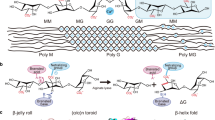Abstract
Alginate-entrapped cells ofM. pruriens were able to convert a number of parasubstituted monophenolic compounds into the corresponding catechols. All catechols produced were released into the medium, which offered the opportunity to isolate these products via a relatively simple procedure. Prepurification was performed on a Sephadex G10 gel and catechols were concentrated on Affigel 601. The identity of all products was confirmed with combined liquid chromatography/mass spectrometry (LC/MS) or MS using the desorption chemical ionization technique, depending on the catechol. For the entrapped cells and for a cell homogenate prepared of the same cell line ofM. pruriens the substrate specificities were qualitatively identical when judged on initial rates of synthesis calculated on protein basis.
Similar content being viewed by others
References
Huizing HJ, Wichers HJ (1984) Production of L-DOPA byMucuna pruriens cell suspension cultures through accumulation or by biotransformation of tyrosine. In: Houwink EH, Van der Meer R (eds.) Innovations in Biotechnology, Progress in Industrial Microbiology 20, pp 217–228. Elseviers Science Publishers B.V., Amsterdam
Wichers HJ, Malingré ThM, Huizing HJ (1983) The effect of some environmental factors on the production of L-DOPA by alginate entrapped cells ofMucuna pruriens. Planta 158: 482–486
Wichers HJ, Peetsma GJ, Malingré ThM, Huizing HJ (1984) Purification and properties of a phenoloxidase derived from suspension cultures ofMucuna pruriens. Plant 162: 334–341
Wichers HJ, Pras N (1984) Optimization of the biotransformation of L-tyrosine into L-DOPA and transformation spectrum of alginate-entrapped cells ofMucuna pruriens. In: Proc 3rd European Congress on Biotechnology 1: 217. Verlag Chemie, Weinheim
Bruins AP Pras N (1984) Isolation of 3,4-dihydroxyphenylacetic acid produced from p-hydroxyphenylacetic acid by immobilized plant cells ofMucuna pruriens and its identification by Liquid Chromatography/Mass Spectrometry. Anal Chim Act 163: 91–100
Bruins AP (1980) Probe for the introduction of nonvolatile solids into a chemical ionization source by thermal desorption from a platinum wire. Anal. Chem. 52: 605
Pras N, Batterman S, Wichers HJ, Malingré ThM (1987) A general method for the determination of protein in plant cells and application in plant cell biotechnology (Planta Medica, submitted)
Sheenan JC, Yang DDH (1958) The use of N-formyl-amino acids in peptide synthesis. J Am Chem Soc 80: 1154–1158
Bruins AP, Drenth BFH (1983) Experiments with the combination of a micro liquid chromatograph and a chemical ionization quadrupole mass spectrometer, using a capillary interface for direct liquid introduction. J Chromatgr 271: 71
Bruins AP (1985) Developments in interfacing microbore high performance liquid chromatography with mass spectrometry (a review). J Chromatogr 323: 99
Blakley CR, Vestal ML (1983) Thermospray interface for liquid chromatography/mass spectrometry. Anal Chem 55: 750
Brodelius P, Mosbach K (1982) Immobilized plant cells: general aspects. J Chem Tech Biotechnol 32: 330–337
Covey TR, Lee ED, Bruins AP, Henion JD (1986) Liquid chromatography/mass spectrometry. Anal Chem 58: 1451A
Mattiasson B, Hahn-Hägerdal B (1982) Microenvironmental effects on metabolic behaviour of immobilized cells. A hypothesis. European J Appl Microbiol Biotechnol 16: 52–55
Dainty AL, Goulding KH, Robinson PK, Simpkins I, Trevan MD (1985) Effect of immobilization on plant cell physiology-real or imaginary? Tr in Biotechnol 3, 88: 59–60
Lindsey K, Yeoman MM (1984) The synthetic potential of immobilized cells ofCapsicum fructescens Mill cv. annuum. Planta 162: 495–501
Galun E, Aviv D, Dantes A, Freeman A (1980) Biotransformation by plant cells immobilized in cross-linked polyacrylamide-hydrazide. Planta Med 49: 9–13
Alfermann AW, Schuler I, Reinhard E (1980) Biotransformation of cardiac glycosides by immobilized cells ofDigitalis lanata. Planta Med 40: 218–223
Furuya T, Yoshikawa T, Taira M (1984) Biotransformation of codeinone to codeine by immobilized cells ofPapaver somniferum. Phytochem 23, 5: 999–1001
Author information
Authors and Affiliations
Rights and permissions
About this article
Cite this article
Pras, N., Wichers, H.J., Bruins, A.P. et al. Bioconversion of para-substituted monophenolic compounds into corresponding catechols by alginate entrapped cells ofMucuna pruriens . Plant Cell Tiss Organ Cult 13, 15–26 (1988). https://doi.org/10.1007/BF00043043
Received:
Accepted:
Issue Date:
DOI: https://doi.org/10.1007/BF00043043



